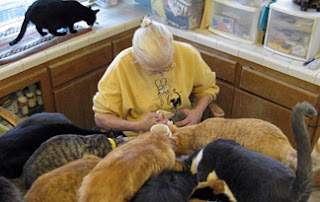Animal hoarding in the US, What is Animal Hoarding? Animal hoarding is defined as a compulsive need to possess and control animals.
Animal Hoarding by the Numbers:
- Animal hoarding impacts communities across the U.S. on a daily basis with approximately 3,500 reported new cases discovered each year. However, there are many cases that go unreported.
- There are approximately 250,000 reported animals that are victims of animal hoarding every year. However, there are many cases that go unreported.
- Animal hoarding in adults often is triggered by an event or situation such as the loss of or stress in a relationship, economic hardship or a major health issue.
- Animal hoarders have also been known to hoard objects; approximately 40 percent of object hoarders also hoard animals.
What Defines Someone as an Animal Hoarder?
Some animal hoarders deny that they are hoarders. They maintain a state of denial because they emphasize to themselves and to others that they acquire a high and unmanageable number of animals because they love animals and the animals need their love. Often, they confuse good intentions with their actions.
- There are three key indicators that define someone as an animal hoarder:
- The person has more than the typical number of animals in the home.
- The person has an inability to provide even the minimum standard of care related to diet, cleanliness, shelter and veterinary care.
- The person is in a state of denial regarding his/her inability to provide this minimum care and denies the impact this has on the animals and other people that live in the home.
- There's no such thing as "the typical" animal hoarder. Hoarders can be all ages, from several socio-economic backgrounds, and are both male and female.
- Animal hoarders often fall into one of the following three categories but can sometimes exhibit characteristics across categories:
- The Overwhelmed Caregiver: The overwhelmed caregiver initially provides adequate care for the animals and believes that while a problem has slowly developed, it's not as serious as others think it is. The overwhelmed caregiver may be socially isolated but is willing to accept intervention.
- The Rescuer Hoarder: The rescuer hoarder develops a compulsion based on a strong desire to rescue animals from possibly deadly situations. He/she actively acquires animals and believes no one else is capable of caring for them. Often working with a network of enablers, the rescuer hoarder gains proximity to the animals and finds it difficult to refuse taking in any new animals.
- The Exploiter Hoarder: The exploiter hoarder takes in animals to serve his/her own needs and is indifferent to any harm caused to the animals. Typically denying a problem exists, this type of hoarder rejects authority figures or any outside help and has a strong need to be in control while expressed very little remorse or guilt. The exploiter hoarder may continue to acquire animals over time.
- Individuals at the beginning stages of hoarding exhibit some ability to care for their animals. If they are aware a problem is developing, they are unable to correct it. Therefore, conditions for the animals continue to deteriorate.
- The breeder-hoarder initially breeds animals for sale and becomes overwhelmed with the amount of care they require and the sheer number of animals in the home. This type of hoarder doesn't recognize the severity of the conditions to which the animals are subjected.
What Types of Animals do People Hoard?
- People hoard all types of animals, not just cats and dogs. There are cases of those who hoard rabbits, birds, ferrets and farm animals such as chickens and goats. There are even cases of exotic animal hoarding, such as snakes and lizards.
- Domestic pets are the largest group of animals represented in hoarding cases, most likely because they are easier to acquire and care for. Cats are very common and contribute to the "cat lady stereotype" often associated with animal hoarding. Cats not only are easy to obtain, they are also easier to conceal than dogs.
- In most hoarding cases, individuals tend to concentrate on one species, but it's not uncommon for a person to hoard a range of animals.
How are the Animals Affected?
The consequences for hoarded animals vary in each case depending on how long the behavior remains undiscovered. In some cases, there are few visible signs of animal suffering, though animals suffer from lack of exercise, the stress of chronic confinement, crowding, fear and lack of socialization. Physical signs of suffering include weight loss, poor hair coat and parasites. As conditions deteriorate and animals accumulate, ammonia levels increase from feces and urine, and infectious diseases spread. Additionally, injuries, illnesses and starvation may begin to set in.
Wednesday, June 19, 2013
Subscribe to:
Post Comments (Atom)







0 comments:
Post a Comment